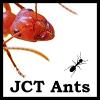My Lasius umbratus colony from 2016, caught her after a nuptial flight.
This is my first queen succeeding to stay alive after getting accepted by the host workers.
And i tried a very lot of times ![]()
She did need to murder the queen of the host colony a small lasius niger colony. ![]()
I was lucky enough, to see this with my very own eyes! I made a little video out of it.
A bit later, there where new workers hatching!
And I made a new video of the colony, I'm starting to get used to making videos. But i still need to learn a lot!
So I love to mix my ant hobby with my YouTube channel!
Hope you guys enjoy, leave a message if so! ![]()


















